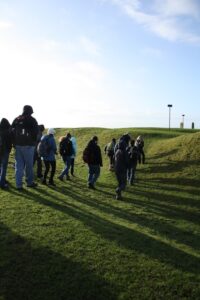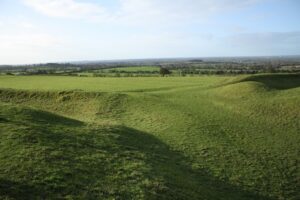After the first couple of weeks of classes, we finally got to take the classroom on the road and see first-hand the subject matter we have been learning about. While PowerPoint is better than old textbook pictures, and museum trips can teach you a lot, having the chance to stand high on the top of an ancient burial tomb where kings once stood, is an opportunity not to be missed.
For our first “reserved Friday,” our Early Irish History class ventured out to the countryside north of Dublin to the Hills of Tara to explore. Our professor also invited a group of study-abroad students from another school, so right away the trip was a social event. The bus ride to Tara was especially exciting when we finally saw sheep in the fields for the first time since arriving in Ireland. Once we got there, we were greeted with beautiful views, cold wind, and muddy grass. The narrow sheep gates and small opening in the stone wall forced us to enter single file. After saying hello to the statue of St. Patrick and passing through the church grounds, we headed into the fields to look at the Ráith na Ríog (Fort of the Kings) where the Kings of Tara once sat. The site itself is a series of circular mounds surrounded by a large ditch and bank, but hearing the history makes it seem incredible.
We were then given the opportunity to test our luck with the legend of the standing stone. Story has it that if you are destined to be king, the stone will whisper to you when you hug it. It was on this same spot that the king would be crowned. Sadly, no one in our group is destined to be king!
By this point, everyone was happy to just be wearing a hood! It was so cold that our hands and toes were numb, so we hiked back over the muddy ground to warm up with some coffee or hot chocolate before heading to our next location.
The original plan was to go to Loughcrew, also known as the Hill of the Witch, a Neolithic passage tomb dating to 3000 BC. However, due to the weather conditions, we changed our course to go see the site of the Stone Age Passage Tomb at Newgrange in the Boyne Valley. The tomb is known for the illumination of its passage and chamber by the winter solstice sun. Since we didn’t have a reservation, we weren’t able to go in to the actual tomb, but we were allowed to walk through the museum and the small replica of the tomb, as well as watch a video about the history of the site. There were some interesting artefacts on display and I would definitely like to go inside the real tomb if I get the opportunity.
Both locations were amazing sites, full of ancient history that I would recommend putting on your “Places to See” list if in Ireland. And if I could offer you any advice, it would be wear waterproof boots, warm socks, gloves, and a hat! This was a field trip to remember and I look forward to future trips that are being planned!
Dayna Comeau- Dublin Spring 2012


